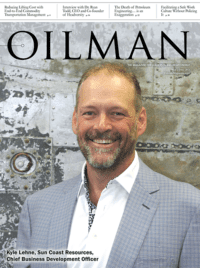 While graduating from Texas A&M with a mechanical engineering degree, Dillon Bloodworth never expected that he would later be paving the way with an intuitive app designed to bring safety awareness straight to the hands of a workforce that needed it most. Now, with his Oilfield Lessons Learned app, he can reach an audience as large as the number of people who own smartphones.
While graduating from Texas A&M with a mechanical engineering degree, Dillon Bloodworth never expected that he would later be paving the way with an intuitive app designed to bring safety awareness straight to the hands of a workforce that needed it most. Now, with his Oilfield Lessons Learned app, he can reach an audience as large as the number of people who own smartphones.
Bloodworth initiated his oil and gas career in 2013 as an operations engineer with BHP and now serves the industry as a company man. Throughout the duration of his career, he has witnessed his share of unsafe behavior and incidents, but it was the repetitiveness that served as the catalyst for his development of Oilfield Lessons Learned. He recounts an incident where a crewmember received burns from contaminated water and then discovered that the same incident occurred five years prior with another individual.
“This showed [that] the lack of accessibility of knowledge can be a major problem,” says Bloodworth. “At the time, there was no way of sharing incidents well. Companies were passionate about lessons learned but, when it came time to share or pull up old ones, it was in a database on your desktop or a file share that you could not filter well and could not give to everyone on location.”
Bloodworth instantly realized that a simple solution was possible, but the disconnect was a failure to realize how important it was to make the information directly accessible by field personnel. He decided to develop a solution of simplicity. The ability to populate a database with mistakes and safety incidents and enable these instances to be shared would prevent death and loss of jobs. Oilfield Lessons Learned accomplishes this feat by providing these various instances for all to read, study, discuss and use as a learning tool.
Oilfield Lessons Learned provides actual instances that serve as robust lessons designed to educate subscribers to prevent future occurrences. To accomplish this, real and applicable data must be collected, which takes place through the mobile application. The challenge is in getting individuals to come forward and provide the data.
“We have struggled to find personnel willing to submit incidents due to fear of company retribution,” says Bloodworth. “When I reach out, however, they will send me the incident, ask me to scrub the data, and then I post it on the application. We have recently made the app anonymous to protect our users as much as possible.”
To be proactive, Oilfield Lessons Learned favors presenting information with corrective actions that are specific in nature. In an industry that emphasizes legalities and liabilities, publishing this exemplary quality of corrective actions can be met with a whole new set of challenges. A certain responsibility accompanies the act of publishing mitigative acts that could enact liability issues of their own should they themselves fail if a subscriber attempts to use them in similar situations for which they were developed.
“Much like IADC and BSEE, they cannot be held responsible by users by agreeing to the terms; we cannot be held responsible either in the same way,” says Bloodworth. “Our user IDs are protected as well. We don’t even allow users to input their full names, so we rely on being anonymous.”
The process of accessing the information from one’s trusty smartphone could not be easier. A simple download of the app and one is off and running to a safer work experience. Featured safety incidents are provided when opening the app and contain a synopsis of the incident. Recommendations are provided and the hazards are listed. Even the person responsible for the occurrence is made known. All this information serves as a collection of tools for the subscriber and is utilized to avoid similar situations and outcomes. A comment section allows the subscriber to provide feedback. This capability directly involves the user, but the functionality does not end there.
The filtering process proves to be quite useful. The app can match incidents in your areas using location services. Additionally, incidents are searchable by various tags such as alarms. Categories also can be the center of an incident search and include topics such as drilling, casing and cementing. If the subscriber is interested in seeing data specific to a general area other than his own, searches can be isolated to regions like the Permian and Haynesville plays. Even the person responsible for the incident is searchable by occupation like the company representative or tool pusher. The significance of such functionality provides a surplus of options in providing information to the user. The scenarios compiled are only valuable if they are located and used. These multiple methods of extraction make this possible.
Bloodworth indicates that the filtering process was a major concern when developing the app. Discussions with Schlumberger and bp personnel provided the direction taken as their systems were difficult to navigate as incidents were hard to locate because keywords did not allow for the process of filtering down.
“With our trickle-down filtering, you can either find out if the incident you’re looking for is there or, if it’s not, as well as overlapping safety categories,” says Bloodworth. “Another user at bp recently said he wanted a system where he could pull all dropped objects and all working at heights but in many systems, you have to choose one or the other when submitting an incident. In our system, you can select multiple entries.”
The Oilfield Lessons Learned app is rooted in a user-friendly website, Oilfield Safety Software | R-14 Apps | Lessons Learned App (oilfieldlessons.com), where how-to directions can be found to provide a step-by-step guide to using the app. Additionally, a barrage of articles on the website expound on the theme of safety. A free demonstration can be taken advantage of so that the user gains the most capability while navigating the app itself. To further allow for ease of use, the app is customizable and live support is available.
According to Bloodworth, there is a cost associated with app customization. Specific inputs and outputs can be crafted to the user’s liking. Companies that use the app also can have it designed to display incident submissions for only their list of users. In the spirit of the app and using the information for all to learn from, Bloodworth does not necessarily favor such customization efforts.
“This detracts from our current mission, but could be a start, where we could incentivize them to submit incidents to the general database for a cut of their monthly costs.”
While safety is a global concern and not exclusive to the oil and gas industry, the Oilfield Lessons Learned concept was designed with a domestic audience in mind. Although it is available to all and the path of least resistance is sought, Bloodworth shares that most users are found outside of the United States.
“The places where we have a majority of our users are Pakistan, India and Sudan. These users are reaching out to me to ask for more content local to their area that they can learn from. So, our largest growth may be in the second and third world nations that are coming into the drilling game.”
When discussing input by major players such as Chevron and Royal Dutch Shell, Bloodworth feels they have their own systems in place and would not likely deviate toward his concept. However, he suggests companies of such size and magnitude might be more in tune with displaying good social proactiveness by supporting a collaborative process like Oilfield Lessons Learned.
“The world is becoming more open-sourced and collaborative. This is the future of sharing incidents and mistakes. I just don’t know which major is going to support us first.”
Bloodworth’s commitment to ensuring a safe working environment is a direct influencer of his primary goal, which is arming oil and gas workers with all industry mistakes and incidents so they can learn from these occurrences and refrain from repeating them. He wants to perfect the system for oil and gas and then continue his mission by targeting additional high-risk industries like construction.
Taking on incidents and injury with smart technology, the Oilfield Lessons Learned concept supplies everything needed to combat unwanted outcomes. Each pathway can lead to success. The challenge is simple utilization.
“Even with me it’s a struggle to review one lesson per day but, when I do it diligently at work, I notice I am more aware of the mistakes and incidents that can happen,” says Bloodworth. A summarization of success can easily be defined as simple repetition in using the Oilfield Lessons Learned app to eliminate repetition of incident and injury.
Headline image courtesy of OilfieldLessons.com
Nick Vaccaro is a freelance writer and photographer. In addition to providing technical writing services, he is an HSE consultant in the oil and gas industry with twelve years of experience. Vaccaro also contributes to SHALE Oil and Gas Business Magazine, American Oil and Gas Investor, Oil and Gas Investor, Energies Magazine and Louisiana Sportsman Magazine. He has a BA in photojournalism from Loyola University and resides in the New Orleans area. Vaccaro can be reached at 985-966-0957 or nav@vaccarogroupllc.com.






